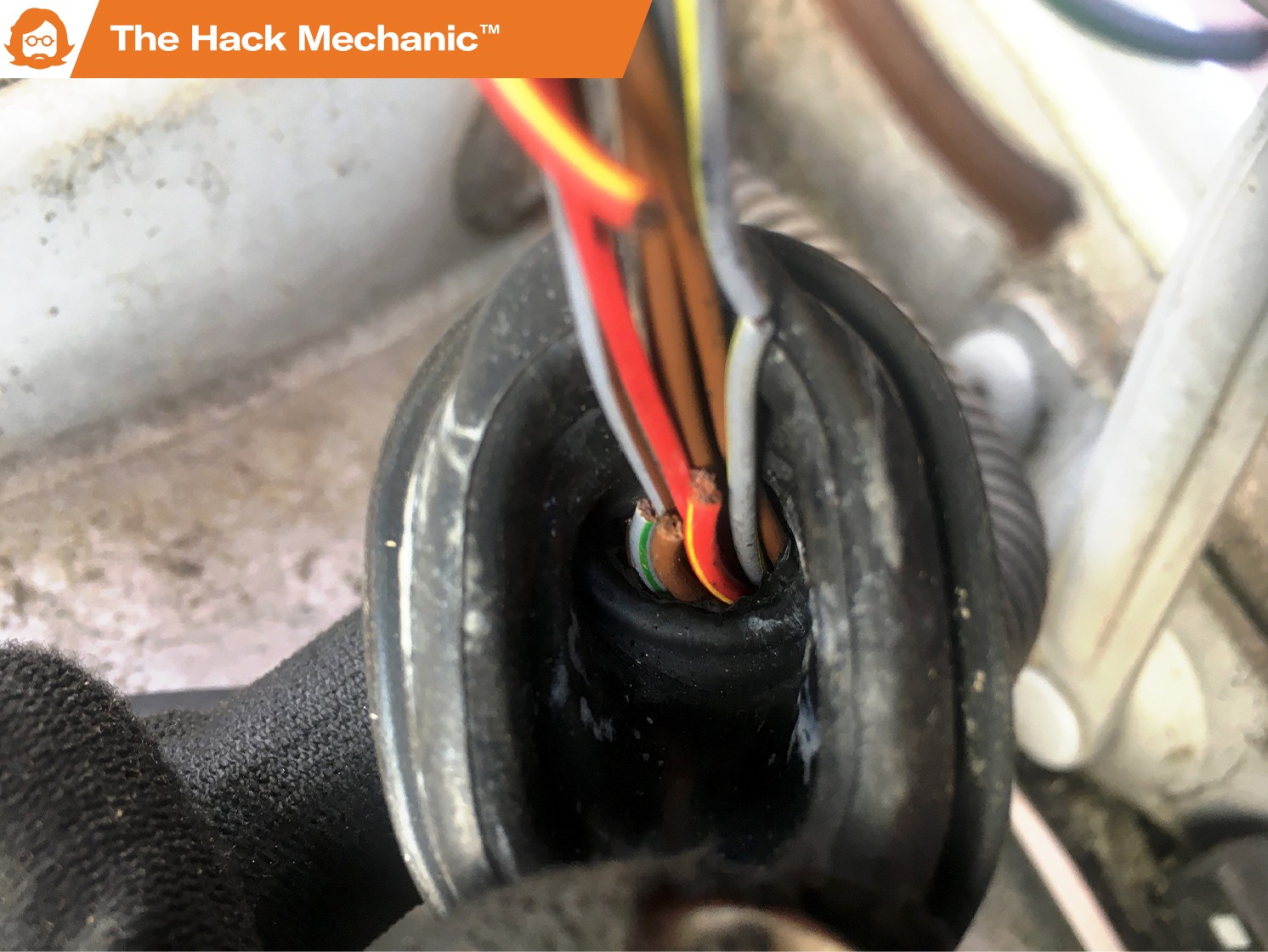Discovering electrical issues in your car can be frustrating. From malfunctioning lights to non-responsive accessories, a broken wire can be the culprit behind a range of problems. While it might seem daunting, repairing a broken wire on your car is a manageable DIY task with the right knowledge and tools. This guide will walk you through the process, ensuring you can confidently tackle this common automotive repair.
Identifying a Broken Wire: Symptoms and Diagnosis
Before diving into the repair, it’s crucial to accurately diagnose a broken wire. Often, the symptoms can be misleading, pointing to other potential issues. Here’s how to identify if a broken wire is indeed your problem:
Common Symptoms of Broken Car Wires:
- Intermittent Electrical Issues: Problems that come and go, especially with movement of the car or specific parts like doors or the trunk lid, often indicate a wire that’s broken or frayed within a flexing harness.
- Non-functioning Components: A sudden failure of a car component, such as a trunk light, license plate light, power window, or central locking system, could be due to a severed wire supplying power or signal.
- Dashboard Warning Lights: Unexpected warning lights on your dashboard, especially related to lighting or electrical systems, can be triggered by a break in the wiring. Inaccurate “trunk open” warnings, as experienced in the original article, are a prime example.
- Blown Fuses: While blown fuses can indicate various electrical problems, repeated fuse failures in a specific circuit might suggest a short circuit caused by damaged wire insulation or a broken wire touching ground.
Diagnostic Steps to Confirm a Broken Wire:
-
Visual Inspection: Start with a careful visual check. Look for:
- Exposed or frayed wires: Pay close attention to areas where wiring harnesses flex, such as door jambs, trunk and hood hinges, and around the engine bay.
- Damaged wire insulation: Cracks, cuts, or melting of the insulation can indicate underlying wire damage.
- Corrosion or rust: Check connectors and terminals for signs of corrosion, which can lead to wire breakage or poor electrical contact.
Image of a mechanic inspecting a car’s wiring harness, emphasizing the visual check for identifying potential broken wire locations.
-
Multimeter Testing: A multimeter is your best friend when diagnosing electrical issues. Use it to check for:
- Continuity: With the circuit de-energized, test for continuity along the wire in question. A lack of continuity confirms a break in the wire.
- Voltage: Check for voltage at the component that is not working. If voltage is absent when it should be present, trace back along the wire to find the break.
- Ground Issues: Ensure the ground wire is properly connected and has continuity to the vehicle’s chassis. A faulty ground can mimic symptoms of a broken power wire.
-
Wiring Diagrams: Consult your car’s wiring diagrams (found in repair manuals or online databases) to understand the circuit layout. This helps you trace wires and identify potential break points more efficiently.
Tools and Materials for Wire Repair
Once you’ve confirmed a broken wire, gather the necessary tools and materials. Having everything ready will streamline the repair process.
Essential Tools:
- Wire Strippers/Crimpers: For removing wire insulation and crimping connectors. Choose a quality tool that can handle various wire gauges.
- Soldering Iron and Solder: For creating a robust and conductive soldered connection.
- Heat Gun or Hair Dryer: To shrink heat shrink tubing for insulation and weatherproofing.
- Multimeter: For testing continuity and voltage throughout the repair process.
- Utility Knife or Scissors: For carefully slitting wire sheathing and trimming wires (use cautiously to avoid further wire damage).
- Pliers: For manipulating wires and connectors.
- Wire Gauge Tool: To identify the correct gauge of wire you are working with, ensuring you use the appropriate replacement wire if needed.
Materials You’ll Need:
-
Replacement Wire: Choose wire of the same gauge and type (stranded copper wire is standard in automotive applications) as the broken wire. It’s advisable to have a selection of colors to match the original wiring where possible for easier tracing in the future.
-
Butt Splice Connectors: For quick and easy crimp connections. Useful when space is limited.
-
Heat Shrink Solder Connectors: Combine soldering and heat shrinking in one step for a weatherproof and durable connection.
-
Heat Shrink Tubing: For insulating soldered or crimped connections and providing extra protection against moisture and abrasion.
-
Electrical Tape: As a secondary insulation layer and for bundling wires.
-
Flux (for soldering): Essential for ensuring solder flows properly, especially on older wires that may have oxidation.
-
Cable Ties or Wiring Harness Tape: To neatly bundle and secure the repaired wires, mimicking the original harness layout.
Image showcasing the tools and materials needed for car wire repair, including wire strippers, soldering iron, connectors, and heat shrink tubing.
Step-by-Step Guide to Repairing a Broken Car Wire
Now, let’s get to the actual repair. Follow these steps to effectively fix a broken wire on your car:
-
Disconnect the Battery: Safety first! Always disconnect the negative terminal of your car battery before working on any electrical components. This prevents accidental shorts and potential damage to your car’s electrical system.
-
Access the Broken Wire: Carefully expose the broken wire. If it’s within a wiring harness, you may need to gently slit the protective sheathing (like the rubber boot in the example article). Be cautious not to damage any other wires in the process.
Image illustrating the process of accessing broken wires within a car’s wiring harness by carefully opening the protective sheath.
-
Prepare the Wire Ends: Inspect the broken wire to determine the best repair method.
- If the break is clean and the wire ends are in good condition: You can proceed with splicing directly.
- If the wires are corroded or damaged: Cut back the wire to expose clean, uncorroded copper. Use wire strippers to remove about ½ inch of insulation from each broken end.
-
Choose Your Splicing Method: Select the appropriate splicing method based on the location, wire type, and your skill level.
-
Butt Splice Connectors (Crimping): This is the quickest method.
a. Insert the stripped ends of the broken wires into opposite ends of a butt splice connector.
b. Use wire crimpers to firmly crimp the connector onto the wires, creating a secure mechanical and electrical connection.
c. For added protection, especially in exposed areas, slide heat shrink tubing over the connector and shrink it with a heat gun.Image showing a butt splice connector, highlighting its use for joining broken wires in car repair.
-
Heat Shrink Solder Connectors: Combines soldering and insulation in one step.
a. Slide the heat shrink solder connector onto one of the stripped wire ends.
b. Twist the stripped ends of the broken wires together so they overlap within the solder ring of the connector.
c. Use a heat gun to heat the connector. The solder will melt and flow, creating a soldered joint, and the heat shrink tubing will simultaneously shrink, insulating the connection. -
Soldering and Heat Shrink Tubing (Manual Soldering): This method provides the most durable and professional repair, especially for wires in high-flex areas.
a. Splice Wire Preparation (Optional but Recommended for High-Flex Areas): Cut a length of new wire of the same gauge, a few inches longer than needed for the splice. Strip both ends of this splice wire and the broken wire ends.
b. Hook and Solder: Create small hooks at the ends of the broken wire and the splice wire (if using). Interlock the hooks, then crimp or twist them together for a mechanical connection.
c. Soldering: Heat the wire joint with a soldering iron and apply solder to the heated joint. Ensure the solder flows smoothly into the wire strands, creating a solid connection. Use flux if necessary to aid solder flow, especially on older wires.
d. Insulation with Heat Shrink Tubing: Once the solder joint has cooled, slide heat shrink tubing over the soldered connection, ensuring it covers the entire exposed wire area and extends onto the original insulation. Use a heat gun to shrink the tubing, providing insulation and strain relief.Image demonstrating the process of soldering a broken car wire, emphasizing the creation of a strong and conductive joint.
-
-
Test the Repair: Before fully reassembling everything, reconnect the battery (negative terminal) and test the repaired circuit. Turn on the ignition and check if the previously malfunctioning component now works correctly (e.g., trunk light, power lock). Use a multimeter to verify voltage and continuity at the repaired connection if needed.
-
Insulate and Protect the Repaired Wires: Ensure the repaired section is well-insulated and protected.
- Heat Shrink Tubing: If you haven’t already, use heat shrink tubing over any exposed connections.
- Electrical Tape: Wrap electrical tape around the repaired section for extra insulation and protection, especially if using butt splice connectors.
- Wiring Harness Tape or Cable Ties: Neatly bundle the repaired wires and secure them to the existing wiring harness using wiring harness tape or cable ties, mimicking the original routing and securing method. This prevents chafing and future damage.
- Reassemble Protective Sheathing: If you opened a wiring harness sheath, re-wrap it with new sheathing or electrical tape to protect the wires from the elements and abrasion.
Image showing heat shrink tubing being applied to a repaired wire connection using a heat gun, highlighting the insulation process.
-
Final Testing and Reassembly: After securing and insulating the repaired wires, perform a final test to ensure everything works as expected. Turn the ignition on and off, operate the repaired component (e.g., open and close the trunk, test the lights), and verify that there are no more warning lights on the dashboard. Once you are satisfied, fully reassemble any trim panels or components you removed to access the wiring.
Image of a completed car wire repair, showing the wires neatly bundled and protected within a new conduit, signifying a successful fix.
Tips for Successful Car Wire Repair
- Use the Right Wire Gauge: Always use replacement wire of the same gauge or slightly larger than the original wire to ensure proper current carrying capacity and prevent overheating.
- Stagger Splices: If repairing multiple broken wires in a harness, stagger the splices along the harness length to avoid creating a bulky, inflexible section.
- Weatherproof Your Connections: Automotive environments are harsh. Ensure all connections are well-insulated and protected from moisture and corrosion using heat shrink tubing and proper sealing techniques.
- Take Your Time: Rushing can lead to mistakes. Work methodically, double-check your connections, and test frequently throughout the process.
- Consult a Professional if Unsure: If you are uncomfortable working with car electrics or encounter complex wiring issues, don’t hesitate to seek help from a qualified automotive electrician.
Repairing a broken wire on your car, while sometimes intricate, is a rewarding skill that can save you money and keep your vehicle in top working order. By following these steps and tips, you can confidently diagnose and fix broken wires, ensuring your car’s electrical system remains reliable.


